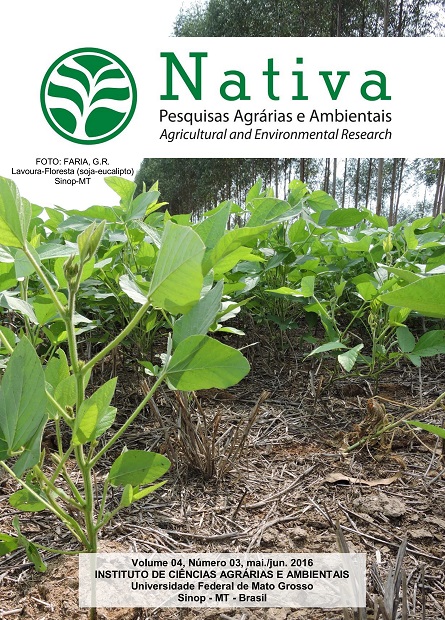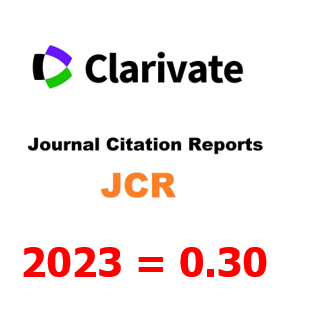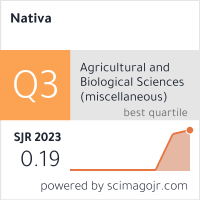COAGULATION/FLOCCULATION OF SLAUGHTERHOUSE WASTEWATER USING COTTONSEED AS COAGULANT
DOI:
https://doi.org/10.31413/nativa.v4i3.3306Resumo
COAGULAÇÃO/FLOCULAÇÃO DE EFLUENTE DE ABATEDOURO UTILIZANDO TORTA DE ALGODÃO COMO COAGULANTE
No presente trabalho, teve-se como objetivo avaliar a influência de um produto natural (torta de algodão), quando utilizado como agente coagulante, na remoção de turbidez de efluente proveniente de um abatedouro de suínos. A torta de algodão foi utilizada como coagulante em três formas de preparação, em solução aquosa utilizandose água destilada, solução salina (NaCl – 1M) e em fase sólida. As soluções aquosas foram preparadas no momento do ensaio. Para avaliação do efeito do coagulante no efluente, foram realizados ensaios de coagulação/floculação/sedimentação utilizando o aparelho Jar- test, sendo avaliados os efeitos das dosagens de50, 100, 200, 500, 1000, 1500, 2500 e 5000 mg L-1 de torta de algodão em solução (aquosa e salina) e 50, 100, 200, 500, 1000 e 1500 mg L-1 de torta de algodão em fase sólida. De acordo com os resultados obtidos, observou-se remoções de turbidez quando da utilização da solução salina (41,1%) com dosagem ótima de 1000 mg L-1 e principalmente quando se utiliza a torta de algodão em fase sólida (43,5%) com dosagem ótima de 100 mg L-1, já que há uma maior superfície de contato, podendo este ser considerado um coagulante potencial no tratamento de efluentes agroindustriais.
Palavras-chave: coagulante natural, tratamento de efluentes, turbidez.
ABSTRACT
The objective of this study was to evaluate the influence of a natural product (cottonseed) when used as a coagulant agent in the turbidity removal from a swine slaughterhouse wastewater. The cottonseed was used as a coagulant in three preparation ways, in aqueous solution using distilled water, saline solution (NaCl - 1M) and in a solid phase. The aqueous solutions were prepared at the time of the test. Coagulation/flocculation/sedimentation tests were performed to evaluate the wastewater coagulant effect using Jar-test device, evaluating the dosages effects of 50, 100, 200, 500, 1000, 1500, 2500 and 5000 mg L-1 cottonseed solution (aqueous and saline) and 50, 100, 200, 500, 1000 and 1500 mg L-1 of solid phase cottonseed. According to the results obtained, the turbidity removals were observed when using saline solution (41.1%) with a great dosage of 1000 mg L-1 and mainly when using solid phase cottonseed (43.5%) with a great dosage of 100 mg L-1, since there is a larger contact surface, which may be considered a potential coagulant in the treatment of agro-industrial wastewater.
Keywords: natural coagulant, wastewater treatment, turbidity.
Referências
AMUDA, O. S.; ALADE, A. Coagulation/flocculation process in the treatment of abattoir wastewater. Desalination, Amsterdam, v. 196, p. 22-31, 2006. http://dx.doi.org/10.1016/j.desal.2005.10.039
APHA - AMERICAN PUBLIC HEALTH ASSOCIATION. Standard methods for the examination of water and wastewater. 21st, Centennial Edition, Washington. 2005.
BAZRAFSHAN, E.; MOSTAFAPOUR, F. K.; FARZADKIA, M.; OWNAGH, K. A.; MAHVI, A. H. Slaughterhouse wastewater treatment by combined chemical coagulation and electrocoagulation process. PLoS One, v. 7, n. 6, p. 1-8, 2012. http://dx.doi.org/10.1371/journal.pone.0040108
BELTRÁN-HEREDIA, J.; SÁNCHEZ-MARTÍN, J.; GÓMEZMUÑOZ, M. C. New coagulant agents from tannin extracts: Preliminary optimization studies. Chemical Engineering Journal, Lausanne, v. 162, p. 1019-1025, 2010. http://dx.doi.org/10.1016/j.cej.2010.07.011
BINA, B.; MEHDINEJAD, M. H.; DALHAMMER, G.; RAJARAO, G.; NIKAEE, M.; MOVAHEDIAN ATTAR, H. Effectiveness of Moringa oleifera coagulant protein as natural coagulant aid in removal of turbidity and bacteria from turbid waters. World Academy of Science, Engineering and Technology, v. 67, p. 617-620, 2010.
CONAMA - CONSELHO NACIONAL DO MEIO AMBIENTE. Resolução 357, de 17/03/05: Classificação dos corpos d’água
e padrões para o lançamento de efluentes. Ministério do Meio Ambiente. 2005.
DROGUI, P.; ASSELIN, M.; BRAR, S. K.; BENMOUSSA, H.; BLAIS, J. F. Electrochemical removal of pollutants from agro-industry wastewaters. Separation and Purification Technology, v. 61, p. 301-310, 2008. http://dx.doi.org/10.1016/j.seppur.2007.10.013
ESCOBAR, F. C.; MARIN, J. P.; MATEOS, P. A.; GUZMAN, F. R.; BARRANTES, M. D. Aerobic purification of dairy wastewater in continuous regime: Part II: Kinetic study of the organic matter removal in two reactor configurations. Biochemical Engineering Journal, Amsterdam, v. 22, p. 117-124, 2005. http://dx.doi.org/10.1016/j.bej.2004.09.009
GARCÍA-FAYOS, B.; ARNAL, J. M.; VERDÚ, G.; SANCHO, M. Aquapot Project: Potential of Moringa oleifera seeds and
its application in drinking water treatment. International Conference on Food Innovation, p. 1-4. 2010
KRIEGER, E. I. F. Avaliação do consumo de água, racionalização do uso e reuso do efluente líquido de um frigorífico de suínos na busca de sustentabilidade socioambiental da empresa. Tese (Doutorado em Ciências, com ênfase em Ecologia) – Universidade Federal do Rio Grande do Sul, Porto Alegre, 2007.
LAYRARGUES, P. P. Sistemas de gerenciamento ambiental, tecnologia limpa e consumidor verde: a delicada relação empresa–meio
ambiente no ecocapitalismo. Revista de Administração de Empresas, São Paulo, v. 40, n. 2, p. 80-88, 2000. http://dx.doi.org/10.1590/S0034-75902000000200009
LUCAS, A.; RODRIGUEZ, L.; VILLASENOR, J.; FERNANDEZ, F. J. Fermentation of agro-food wastewaters by activated sludge.
Water Research, New York, v. 41, p. 1635-1644, 2007. http://dx.doi.org/10.1016/j.watres.2007.01.041
MASSE, D. I.; MASSE, L.; BOUGEOIS, N. Anaerobic processing of slaughterhouse wastewater in a SBR. Dairy and Swine Research and Development Centre, Agriculture and Agri-Food Canada. Quebec, 2000.
MITTAL, G. S. Treatment of wastewater from abattoirs before land application: a review. Bioresource Technology, Essex,
v. 97, p. 1119-1135, 2006. http://dx.doi.org/10.1016/j.biortech.2004.11.021
NKHATA, D. Moringa as an alternative to aluminium sulphate. An article from people and systems for water, sanitation
and health. In: 27th WEDC Conference Lusaka, Zambia. 2001.
OKUDA, T.; BAES, A. U.; NISHIJIMA, W.; OKADA, M. Improvement of extraction method of coagulation active components from Moringa oleifera seed. Water Research, Oxford, v. 33, n. 15, p. 3373-3378, 1999. http://dx.doi.org/10.1016/S0043-1354(99)00046-9
OKUDA, T.; BAES, A. U.; NISHIJIMA, W.; OKADA, M. Coagulation mechanism of salt solution-extracted active component in Moringa oleifera seeds. Water Research, Oxford, v. 35, n. 3, p. 830-834, 2001. http://dx.doi.org/10.1016/S0043-1354(00)00296-7
PACHECO, J. W. F.; YAMANAKA, H. T. Guia técnico ambiental de abate (bovino e suino). São Paulo: CETESB, 2008. Série P+L. ROSA, T. B. D. Gestão ambiental: A responsabilidade ambiental das empresas e a normatização ISSO 14000. UNOPAR Científica, Ciência Jurídica Empresarial, Londrina, v. 13, n.2, pp. 113-116, 2012.
SÁNCHEZ-MARTÍN, J.; BELTRÁN-HEREDIA, J.; SOLERAHERNÁNDEZ, C. Surface water and wastewater treatment using a new tannin-based coagulant. Pilot plant trials. Journal of Environmental Management, London, v. 91, p. 2051-2058, 2010. http://dx.doi.org/10.1016/j.jenvman.2010.05.013
YARAHMADI, M.; HOSSIENI, M.; BINA, B.; MAHMOUDIAN, M. H.; NAIMABADIE, A.; SHAHSAVANI, A. Application of Moringa oleifera seed extract and polyaluminum chloride in water treatment. World Applied Sciences Journal, v. 7, n. 8, pp.962-967, 2009.
Downloads
Publicado
Edição
Seção
Como Citar
Licença
Direitos Autorais para artigos publicados nesta revista são do autor, com direitos de primeira publicação para a revista. Em virtude de a aparecerem nesta revista de acesso público, os artigos são de uso gratuito, com atribuições próprias, em aplicações educacionais e não-comerciais.
A artigos publicados nessa revista, podem ser reproduzidos parcialmente ou utilizados como referência por outros autores, desde que seja cita a fonte, ou seja, a Revista Nativa.
Copyright for articles published in this journal are the authors, with first publication rights granted to the journal. The journal shows open access, and articles are free to use, with proper attribution, in educational and non-commercial.
The articles published in this journal may be reproduced in part or used as a reference by other authors, provided that the source is quoted.






